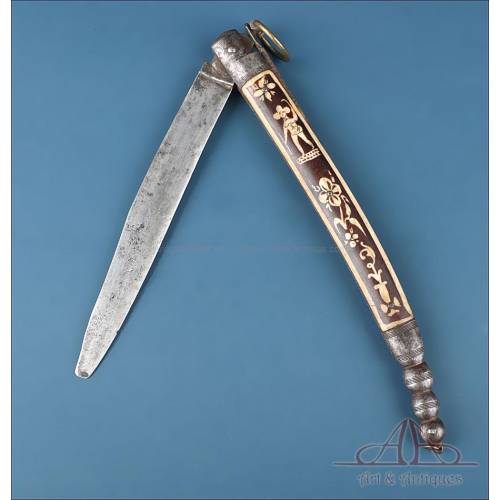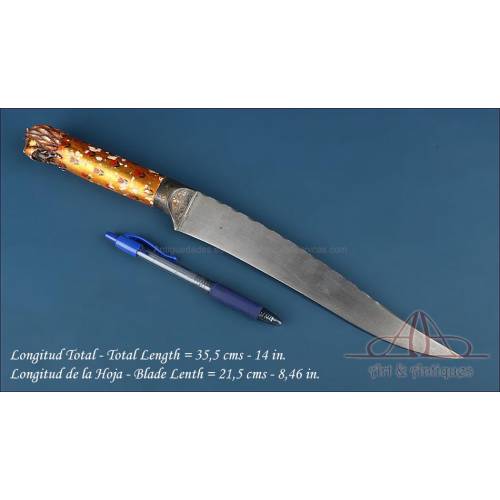Antique Swords
Antique swords make up a very special group of antiques. On the one hand, they are military pieces that should never be missing in a good exhibition of antique weapons. On the other, their beauty and magnificent presence make them items of great decorative potential. Within the term "antique swords" we find many different pieces, each with its ...
Antique swords make up a very special group of antiques. On the one hand, they are military pieces that should never be missing in a good exhibition of antique weapons. On the other, their beauty and magnificent presence make them items of great decorative potential. Within the term "antique swords" we find many different pieces, each with its own name, configuration, function and style. From the imposing old sabers, which used to be part of the equipment of cavalry and infantry corps, to the antique knives made so famous by bandits, period blades continue to arouse a remarkable fascination that increases with the passage of time.
Although many of them have not yet reached the century of antiquity, we can consider old swords the bladed weapons manufactured and used until the end of World War II (1939-1945). This war was dominated by firearms, leaving bladed weapons in the background. However, for centuries they were the most important armament carried by armies, even after the appearance of firearms (which even came to be incorporated in the form of bayonets).
While many military uniforms include sabers and daggers in their equipment, after World War II this practice became regimented, with virtually no practical function. However, we know that Japanese soldiers carried knives called gunto, similar to the famous katanas. The officers of the elite corps of the Nazi army also carried different types of daggers. In this warfare, edged weapons were used in close combat and as a complement to the rest of the armament; for this reason, they were usually short weapons such as daggers or knives. It is worth noting the famous figure of Jack Churchill, a British captain who fought in the war with a bow, arrows and a double-edged sword known as "Claymore" Churchill was captured by the Germans (he made a spectacular escape) and survived World War II, dying in 1996.
Brief history of ancient swords
The first bladed weapons in history date back to the Bronze Age, when the first daggers were forged. It was not until 2000 B.C. that the technique of metal forging led to the development of the first bladed weapons. to the first ancient swords, as we know them today. Then the blades were made of bronze, which made them more fragile; in the 13th century B.C. the first iron swords began to be created. During the Middle Ages and the Renaissance, bladed weapons evolved and models such as sabers, machetes and spadone, large and heavy weapons that were wielded with both hands, appeared. In the Modern Age these weapons become lighter; rapiers and other similar ancient swords appear, incorporating protective measures in the hilt. The development and use of edged weapons continued until World War II; from the end of this conflict, they are used mainly as a complement to dress and parade uniforms.
Types of antique edged weapons
Under the name "edged weapons" we can distinguish the following types:
- Ancient swords:
- Antique sabers: long, curved and single-edged.
- Antique machetes: halfway between sword and knife, they are single-edged and less than 60 cm long.
- Ancient rapiers: also known as "rapier swords", have a long, pointed blade and are wielded with one hand.
- Antique daggers: flat-bladed, usually two-edged and pointed. Shorter than the sword and longer than the dagger.
- Antique daggers: short weapons (between 20 and 30 cm long) and pointed for self-defense. There are different types, among which are the almarada and the stiletto.
- Antique pocket knives: have a blade hidden in a hilt formed by two sides or "cachas". The blade is attached to the hilt by means of a shaft that allows it to be unfolded and hidden.
- Antique bayonets: pointed bladed weapons that were placed in the muzzle of the rifle or carbine for close combat.
- Antique halberds: Wooden spears with a metal tip fitted with an axe-shaped blade.
Antique swords, as well as the rest of the period bladed weapons, make up a universe that exudes fascination. Their details, their quality and their fearsome appearance make them fundamental pieces in any collection of military or war antiques.
Antique Sidearm for Spanish Infantry Officer in Cuba. Spain, Circa 1890 Antique Sidearm for Spanish...
Striking sidearm for Spanish infantry officer in Cuba. Alpaca hilt with lions head. Beautiful piece. Striking sidearm for Spanish infantry...
SoldNapoleonic Light-Cavalry Officer Sword, Mod. AN IX. France, Circa 1810 Napoleonic Light-Cavalry Officer...
Amazing French cavalry officer from the Napoleonic time. Blade with remains of engraved decoration. Well preserved. Amazing French cavalry officer from...
SoldAntique French Navaja or Pocketknife by Coutaret. 16.93 in. 19th Century Antique French Navaja or...
Simple and antique pocketknife signed by Coutaret. Made in the 19th century. In good condition. Simple and antique pocketknife signed...
230,00 € 330,00 €Antique French Pocketknife from Châtellerault. 15.16 inches. France, 19th Century Antique French Pocketknife from...
Gorgeous French pocketknife in good condition. With hand-decorated side plates. Mid-19th century. Gorgeous French pocketknife in good...
SoldAntique Indian Mughal or Khanjar Dagger. Rock Crystal Handle. Damascus, Circa 1900 Antique Indian Mughal or Khanjar...
Wonderful Indian Mughal or Khanjar dagger with carved handle. Very ancient piece in fine condition. Wonderful Indian Mughal or Khanjar...
770,00 € 1 200,00 €Antique Indian Mughal or Khanjar Dagger. Polychrome Carved Lion. Circa 1900 Antique Indian Mughal or Khanjar...
Gorgeous Indian Mughal or Khanjar dagger with carved lion. Polychrome decoration. Gorgeous Indian Mughal or Khanjar...
310,00 € 425,00 €Antique Indian Mughal or Khanjar Dagger with Horse Head. India, Circa 1900 Antique Indian Mughal or Khanjar...
Antique Mughal or Khanjar dagger with hand-carved handle. More than one hundred years old. Antique Mughal or Khanjar dagger with...
SoldAntique French Navy Side Arm for Administravive Officers. France, 2nd Empire, 1860 Antique French Navy Side Arm for...
Sober antique sidearm of administrative officer of the French Navy. With original leather scabbard. Second French Empire. Sober antique sidearm of...
Sold
New products
-

Antique ivory and silver plated stethoscope, late 19th century
Antique stethoscope from the late 19th century in silver-plated metal...
-

Vintage pendant with shell cameo of Jesús del Gran Poder, carved c. 1970
Vintage pendant with a shell-carved cameo of Jesus del Gran Poder, circa...
-

Antique Roman Style Gilded Silver Chalice with Paten. France, 1932
Antique Roman-style chalice in gilded silver with paten. France, 1932....
-

Beautiful Antique 18 K Gold Ring with 7 Natural Diamonds
Antique 18K gold ring with 7 natural diamonds. Delicate openwork design,...
-

Antique Silver Reliquary. José Vilaplana. Valencia, Spain. Circa 1920
Impressive repoussé silver reliquary by José Vilaplana, Valencia, c....
-

Vintage 18K Gold Ring with 7 Natural Diamonds
Vintage 18K gold ring with seven natural diamonds in floral setting....
-

Antique Silver Chalice. Enameled Crosses. Valencia, Spain, 1942
Spanish chalice from 1942 in solid silver, gifted by the Church of...
-

Antique Silver Chalice and Paten. Granada Spain, circa 1900
Spanish chalice in white silver with matching paten, handcrafted....
Specials
-

Antique Silver Pocket Watch Chain. Enamel Decoration. 19th Century
Fine solid-silver pocket watch chain....

















